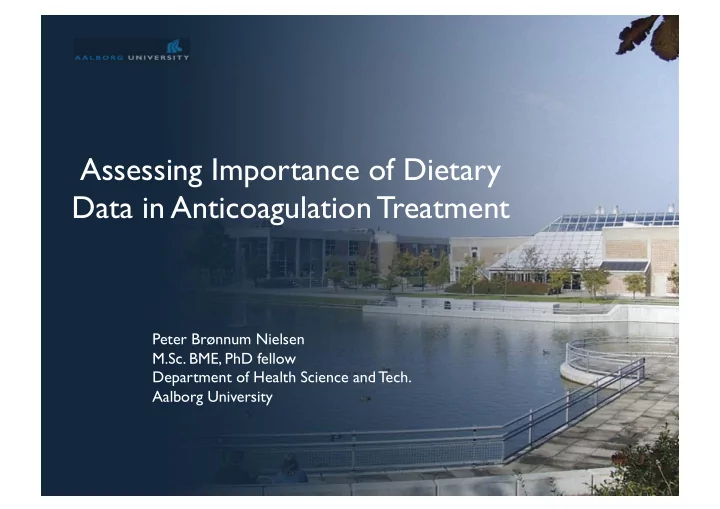

Assessing Importance of Dietary Data in Anticoagulation Treatment Peter Brønnum Nielsen M.Sc. BME, PhD fellow Department of Health Science and Tech. Aalborg University
• Introduction Oral Anticoagulation • Methods and data • Modelling • Results Treatment (OAT) • People with increased risk of thrombosis o Mechanical heart valve replacement o Deep Venous Thrombosis (DVT) o Atrial fibrillation o Pulmonary embolism • Current patient figures o DK 100.000 patients 1 (2% of population) o Expected to rise 1. Holm T, Lassen JF., Ugeskr Laeger , 2003
Treatment • Introduction • Methods and data management • Modelling • Results • Management of daily oral intake of vitamin K antagonists (warfarin) • Monitoring of INR - International Normalized Ratio • Beneficial balance between clotting and tendency to bleed 2 • Affected by dietary vitamin K • Slow-acting physiological system 2. Stafford, DW., J Thromb Haemost , 2005
• Introduction Patient management • Methods and data • Modelling • Results • Conventional treatment o Physician managed INR • Partly managed by patient o Patient self-testing o Patient self-management • Patients have to Vitamin K comprehend: Warfarin
• Introduction Self-management and • Methods and data • Modelling • Results self-testing of OAT • Benefits o Cost-effectiveness o Clinical effectiveness o Reduce frequency of ambulatory visits o Increase quality of life for OAT patients • Risks o Potential lethal drug o Biological variability affecting INR
• Introduction Summary of challenges • Methods and data • Modelling • Results • Medication errors can cause death • INR values are affected by biological variability as dietary vitamin K Utilizing v itamin K information when prediction INR values
• Introduction Methods • Methods and data • Modelling • Results • Metabolic modelling • Collection of data from five patients in “normal, everyday setting” • Data parameters: o INR o Warfarin o Vitamin K o Others
• Introduction Data collection protocol • Methods and data • Modelling • Results • Cooperation with highly specialized ambulatory (Medicinsk Ambulatorium, Brædstrup Sygehus) • Daily scheme to be filled for one month • Mail correspondence once a week No. of days INR TTR Warfarin Mean 27,2 2,5 83,7% 2,5mg Indications for OAT: Heart valve replacement, DVT, or atria fibrillation. Abbreviations: TTR = Time in Therapeutic Range.
• Introduction Modelling • Methods and data • Modelling • Results • Already existing model 3 expanded • Break down into compartments o Warfarin o Coagulation factors o Vitamin K • Predict future INR values 3. Vadher B., J Clin Pathol, 1999
• Introduction Warfarin modelling • Methods and data • Modelling • Results • Warfarin modelled as single compartment • Effect of warfarin on coagulation factors
• Introduction Coagulation factors • Methods and data • Modelling • Results
• Introduction Vitamin K modelling • Methods and data • Modelling • Results • Modelled effect 4 of vitamin K intake upon INR values 4. Schugers LG., Blood, 2004
• Introduction Model summary • Methods and data • Modelling • Results Mathematical overview of model 1. INR(t) = 1+( ∑ [a i ((100-F i )/100) Si ] – VitK) 2. dF i /dt = w ● F syn - F deg 3. w = 1 – tanh (W(t) ● warf-sens ) 4. W(t) = W(0) ● e -(k) ● t
• Introduction Model predictions • Methods and data • Modelling • Results
• Introduction Model prediction results • Methods and data • Modelling • Results
• Introduction Model prediction results • Methods and data • Modelling • Results
• Introduction Model prediction results • Methods and data • Modelling • Results
• Introduction Results for vitamin K • Methods and data • Modelling • Results rich data
• Introduction • Methods and data • Modelling Discussion • Results • Pros o Decision support for management of OAT patients o Help to avoid oscillating INR values o Opportunity to raise patient’s awareness • Cons o Burden of data collection o False or incomplete data pose a potential risk
Thank you for listening Peter Brønnum Nielsen M.Sc. BME, PhD fellow Department of Health Science and Tech. Aalborg University E-mail: pbn@hst.aau.dk
Recommend
More recommend